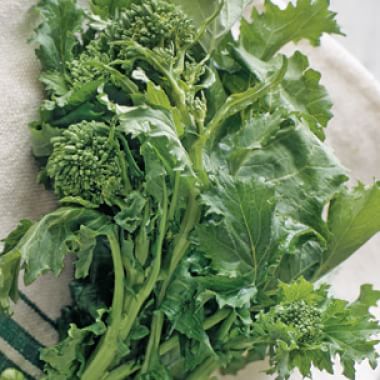
Also called broccoli raab, rapini, or Italian broccoli, broccoli rabe is much loved for its long, slender stalks; abundant, tender, frilled leaves; and distinctive flower buds that resemble small florets of broccoli. Closely related to mustard, broccoli rabe has
a mild, pleasantly bitter taste with overtones of sweet mustard.
At its best in autumn and winter, broccoli rabe is popular in Italian cooking, where it may be sautéed in olive oil and garlic as an accompaniment to meat or as the basis of a pasta sauce. Similarly, in Asia, it is a favorite vegetable for stir-frying with garlic or ginger. It is excellent cooked and chilled in salads or used to top pizzas or bruschetta.
Selecting
Choose broccoli rabe with bright green florets and leaves
and yellow flowers that are just beginning to open. Avoid if the florets are wilted, browned or fully bloomed. The stalks should be firm and can be slightly flexible.
Storing
Store broccoli rabe in a plastic bag in the refrigerator for up to 3 days.
Preparing
Trim away the ends of the stems and any wilted leaves. If any
of the stems are particularly thick or tough, they can be peeled with a vegetable peeler. To reduce broccoli rabe’s bitterness,
it can be steamed, braised in a small amount of water, or blanched before serving or cooking further.
Adapted from Williams-Sonoma Cooking from the Farmers’ Market, by Tasha DeSerio & Jodi Liano (Weldon Owen, 2010).
Related Recipes:
- Toasts with Spicy Broccoli Rabe and Pecorino (Crostini con Rapini Piccanti) →
- Clams with White Beans, Fennel and Broccoli Rabe →
- Sautéed Broccoli Rabe with Garlic, Anchovies and Red Pepper Flakes →
- Rapini with Garlic and Red Pepper →
- Orecchiette with Broccoli Rabe and Sausage →
- Salsiccia Pizza with Broccoli Rabe →
- Whole-Wheat Pasta with Broccoli Rabe →
- Baked Rigatoni with Sausage & Broccoli Rabe →







